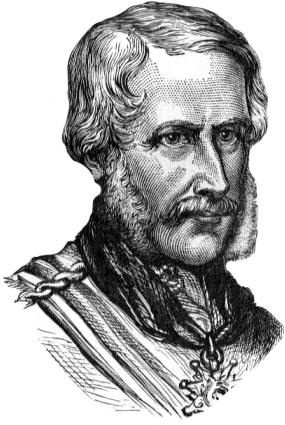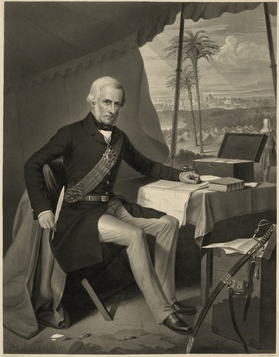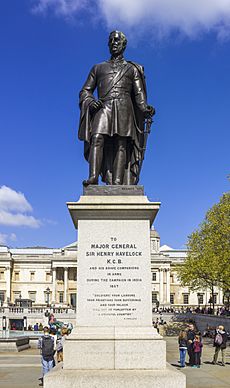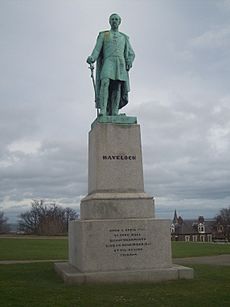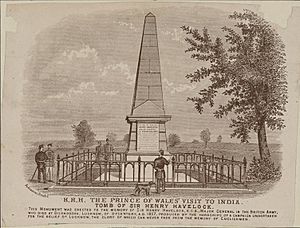Henry Havelock facts for kids
Quick facts for kids
Sir Henry Havelock
|
|
|---|---|
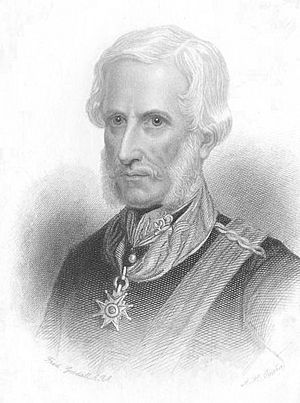
Henry Havelock, 1865 portrait
|
|
| Born | 5 April 1795 Bishopwearmouth, Sunderland |
| Died | 24 November 1857 (aged 62) Lucknow, India |
| Allegiance | United Kingdom |
| Service/ |
British Army |
| Years of service | 1815–1857 |
| Rank | Major General |
| Battles/wars | First Anglo-Burmese War First Anglo-Afghan War First Anglo-Sikh War Anglo-Persian War Indian Rebellion |
| Awards | Knight Commander of the Order of the Bath |
| Relations | Sir Henry Havelock-Allan, 1st Baronet (son) |
Major General Sir Henry Havelock was a brave British general. He is famous for his actions in India, especially during the Indian Rebellion of 1857 (also known as the First War of Independence or Sepoy Mutiny). He led his troops to recapture Cawnpore and relieve Lucknow.
Contents
Early Life and Army Start
Henry Havelock was born on April 5, 1795, in Bishopwearmouth, which is now part of Sunderland. His father, William Havelock, was a rich shipbuilder. Henry was one of four brothers, and all of them joined the army.
When Henry was a child, his family moved to Kent. He went to Dartford Grammar School and later Charterhouse School. After school, his father lost all his money. This meant Henry could no longer study law, which his mother had wanted him to do.
Instead, Henry joined the army in 1815 when he was 20 years old. He became a second lieutenant in the 95th Regiment of Foot. An officer named Captain Harry Smith encouraged him to study military history and how to fight wars. Henry spent eight years in Britain, reading many books about war strategy.
Moving to India and New Beliefs
Henry Havelock decided to go to India because he wanted to see active service. In 1822, he joined the 13th Regiment. He sailed to India in 1823. On the journey, a fellow officer helped Henry rediscover his religious faith. This faith became very important to him for the rest of his life.
Havelock fought well in the First Anglo-Burmese War (1824–1826). After this, he went back to England and married Hannah Shepherd Marshman. Her parents were famous Christian missionaries. Around this time, Henry became a Baptist. He started sharing his new religious ideas with the army. He gave bibles to soldiers and set up bible study classes for all ranks. He also started non-church services for military personnel.
Fighting in Afghanistan and Sikh Wars
By 1839, Henry Havelock was a captain. He took part in the First Afghan War. He was with General Willoughby Cotton when they captured Ghazni and later occupied Kabul.
In 1841, Havelock joined Sir Robert Henry Sale's forces. He fought bravely through difficult mountain passes and helped defeat Wazir Akbar Khan at Jalalabad in 1842. He then helped free British prisoners in Kabul.
Havelock also fought in the Gwalior Campaign in 1843 and the First Anglo-Sikh War in 1845. He was part of important battles like Mudki, Ferozeshah, and Sobraon.
He used his free time to write detailed reports about the battles he was in. These reports were sent back to Britain and published in newspapers. For his service, he was promoted and became Deputy Adjutant-General at Bombay. He returned to England for two years, then came back to India in 1852. He continued to be promoted, becoming a full colonel and Adjutant-General of India by 1854.
The Indian Rebellion of 1857
In 1857, the Indian Rebellion of 1857 began. Sir Henry Havelock was chosen to lead a group of soldiers. Their mission was to stop the rebellion in places like Allahabad, help British forces in Lucknow and Cawnpore, and defeat the rebels.
Throughout August, Havelock led his soldiers north through Oudh (now Uttar Pradesh). Even though his forces were much smaller than the rebels', he defeated them in every battle. His years of studying war and his past experiences helped him greatly. Lady Canning, a high-ranking official's wife, wrote in her diary that Havelock "will do well." He proved her right, becoming known as a great military leader.
Havelock tried three times to relieve the Lucknow. Twice he had to pull back because his troops were tired and sick. Finally, more soldiers arrived, and he was able to capture Lucknow on September 25, 1857. However, another rebel force arrived and surrounded the town again. This time, Havelock and his soldiers were trapped inside.
Henry Havelock died on November 24, 1857, from dysentery, a few days after the siege was finally lifted. He heard that he would be made a Baronet for his bravery. He did not know that he was also promoted to major-general shortly before his death. After he died, his eldest son, Henry, received the baronetcy. Parliament also gave pensions to his widow and son.
Legacy and Memorials
Statue in Trafalgar Square
There is a statue of Henry Havelock in Trafalgar Square, London. The words on the statue's base say: "To Major General Sir Henry Havelock KCB and his brave companions in arms during the campaign in India 1857. 'Soldiers! Your labours, your privations, your sufferings and your valour, will not be forgotten by a grateful country.' H. Havelock"
Statue in Mowbray Park
Another statue of Havelock stands in Mowbray Park in Sunderland, his birthplace. Two replica cannons are placed next to the statue. The statue faces west, towards where he was born.
Tomb in Lucknow
An impressive monument marks Havelock's tomb in Lucknow, India. Verses on his tomb praise his courage and faith.
Other Places Named After Him
- Havelock MRT station and Havelock Road in Singapore.
- Havelock Island in the Andaman Islands (now called Swaraj Dweep).
- Several pubs in England are named "The General Havelock."
- Havelock Road in Luton, England.
- Havelock Guest House in Jersey.


